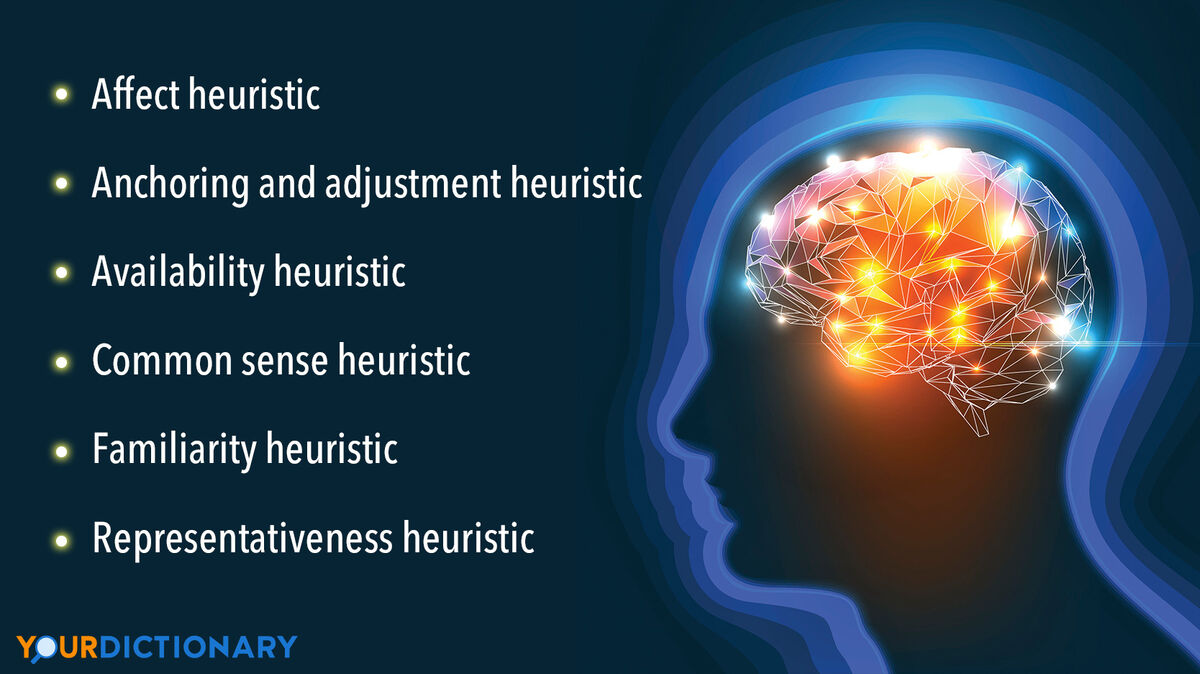
Say someone asks you the circumference of the Earth. Do you attempt to give an approximate answer based on your limited knowledge of the topic, or do you search for the answer? If you try to answer the question, this is an example of heuristics because you are using the knowledge you have on hand to make an educated guess.
What Is a Heuristic?
Heuristic is a word from the Greek heuriskein meaning "to discover." It is an approach to problem-solving that takes one's prior knowledge and personal experience into account. This can include using self-education, evaluation and feedback to cut down on decision-making time and get better, faster results. It can also be as simple as an educated guess.
Types of Heuristics
There are different types of heuristics that people use as a way to solve a problem or to learn something.
affect heuristic - when you make a snap judgment based on a quick impression
anchoring and adjustment heuristic - forming a bias based on initial information to anchor the point and then using additional information to adjust your findings until an acceptable answer is reached
availability heuristic - when you make a judgment based on the information you have available in your mind, whether from memory or from personal experience
common sense heuristic - applied to a problem based on an individual's observation of a situation
familiarity heuristic - allows someone to approach an issue or problem based on the fact that the situation is one with which the individual is familiar, and so one should act the same way they acted in the same situation before
representativeness heuristic - making a judgment about the likelihood of an event or fact based on preconceived notions or memories of a prototype, stereotype or average
Ways to Use Heuristics in Everyday Life
People use heuristics in everyday life as a way to solve a problem or to learn something. By reviewing these heuristic examples you can get an overview of the various techniques of problem-solving and gain an understanding of how to use them when you need to solve a problem in the future.
Examples of Affect Heuristic
When you apply affect heuristic, you view a situation quickly and decide without further research whether a thing is good or bad. This can also be described as an impulsive or emotional decision.
A person is stuck in traffic and makes an impulsive decision to take the other route even though you don’t know the way.
Someone is offered a job and accepts it without further details.
A family chooses to move to another country without being familiar with the language, culture or area.
Examples of Anchoring and Adjustment Heuristic
When you use an anchoring and adjustment heuristic, you use a starting point to anchor your point or judgment, but then you adjust your information based on new evidence.
A salesman initially offering a high price and eventually arriving at a fair value with the customer.
Assuming you know everything you need to know about someone because of their credentials or someone else’s opinion of them.
Trying to guess a price based on past trends.
Examples of Availability Heuristic
When you use an availability heuristic, you use the information available to you to make the best guess or decision possible.
Guessing the population of the city you live in even though you have never looked up the exact number of people.
Estimating how many people attend your school based on how many people you see in your daily life and an educated guess.
Assuming most people in your city will vote a certain way because you and your immediate community are voting that way.
Guessing which university in your state more people will attend based on your inner circle and their school preferences.
Examples of Common Sense Heuristic
Common sense heuristics is a practical and prudent approach that is applied to a decision where the right and wrong answers seem relatively clear cut.
If it is raining outside, you should bring an umbrella.
You choose not to drive after having one too many drinks.
You decide not to eat food if you don’t know what it is.
Examples of Familiarity Heuristic
The familiarity heuristic is when something, someone or somewhere familiar is favored over the unknown.
A group is deciding between a new restaurant and a restaurant they have been to many times and ultimately goes to the restaurant they usually go to.
A driver takes the familiar route to work every day even though there is another, faster way.
Consumers buy the same brands over and over regardless of the quality of the products.
Examples of Representativeness Heuristic
In the original experiment on representativeness heuristic during the 1970s, psychologists Amos Tversky and Daniel Kahneman gave participants descriptions of a man named Tom. They characterized him as organized, detail-oriented, competent, and having a strong moral compass. Based on these details, participants were asked to guess Tom’s college major. Using representativeness, the participants assumed that Tom was an engineering student even though there were relatively few engineering students at the university where the study was conducted.
Assuming someone is arrogant and self-absorbed because they are reserved, quiet and rarely interact with people.
Judging someone’s nationality using only preconceived notions based on the way they look and talk even though you have not spoken to them or learned anything about them.
Guessing that someone who is creative, quirky and dressed colorfully is a humanities major.
Basing your opinion of someone on things others have said about them or your own bias.
Seek Further Knowledge
Check out some other articles we think you’ll enjoy.